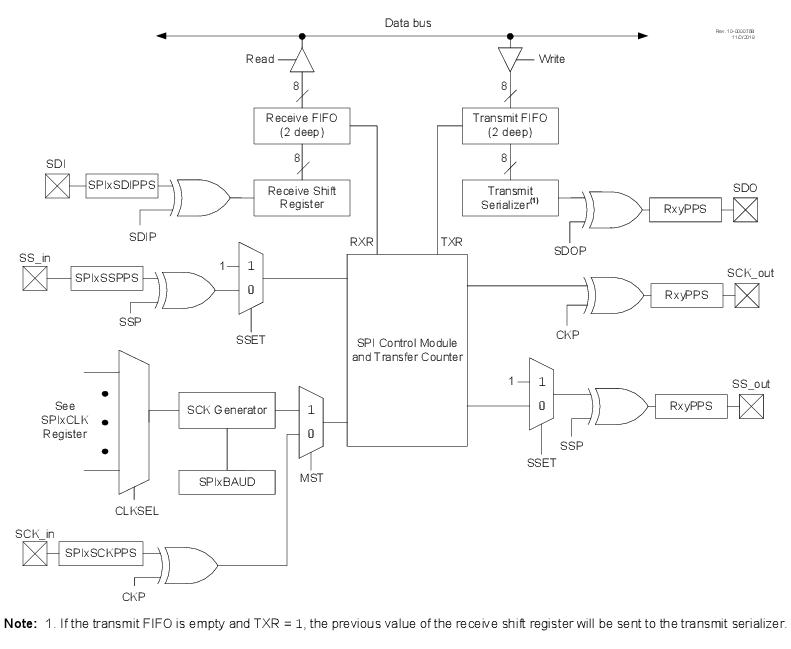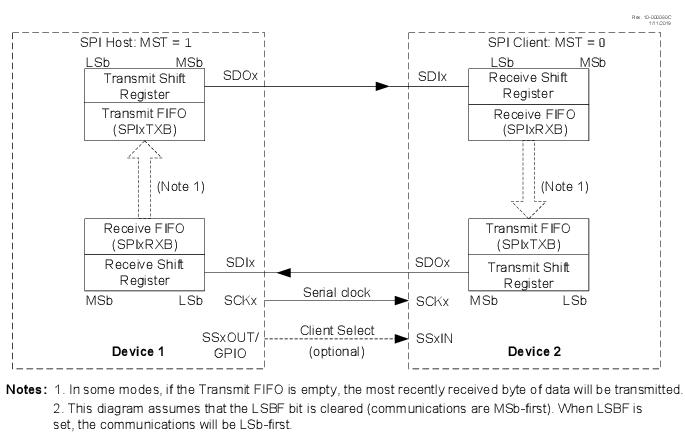36 SPI - Serial Peripheral Interface Module
The Serial Peripheral Interface (SPI) module is a synchronous serial data communication bus that operates in Full Duplex mode. Devices communicate in a host/client environment where the host device initiates the communication. A client device is typically controlled through a chip select known as Client Select. Some examples of client devices include serial EEPROMs, shift registers, display drivers, A/D converters and other PIC® devices with SPI capabilities.
- Serial Clock (SCK)
- Serial Data Out (SDO)
- Serial Data In (SDI)
- Client Select (SS)

The SPI transmit output (SDO_out) is available to the remappable PPS SDO pin and internally to the select peripherals.
The SPI bus typically operates with a single host device and one or more client devices. When multiple client devices are used, an independent Client Select connection is required from the host device to each client device.
The host selects only one client at a time. Most client devices have tri-state outputs so their output signal appears disconnected from the bus when they are not selected.
Transmissions typically involve Shift registers, eight bits in size, one in the host and one in the client. With either the host or the client device, data are shifted out one bit at a time, with the Most Significant bit (MSb) shifted out first. At the same time, a new bit is shifted into the device. Unlike older Microchip devices, the SPI module on this device contains one register for incoming data and another register for outgoing data. Both registers also have multibyte FIFO buffers and allow for DMA bus connections.
The figure below shows a typical connection between two devices configured as host and client devices.

Data are shifted out of the transmit FIFO on the programmed clock edge and into the receive Shift register on the opposite edge of the clock.
The host device transmits information on its SDO output pin which is connected to, and received by, the client’s SDI input pin. The client device transmits information on its SDO output pin, which is connected to, and received by, the host’s SDI input pin.
The host device sends out the clock signal. Both the host and the client devices need to be configured for the same clock phase and clock polarity.
During each SPI clock cycle, a full-duplex data transmission occurs. This means that while the host device is sending out the MSb from its output register (on its SDO pin) and the client device is reading this bit and saving it as the LSb of its input register. The client device is also sending out the MSb from its Shift register (on its SDO pin) and the host device is reading this bit and saving it as the LSb of its input register.
After eight bits have been shifted out, the host and client have exchanged register values and stored the incoming data into the receiver FIFOs.
If there is more data to exchange, the registers are loaded with new data and the process repeats.
- Host sends useful data and client sends dummy data
- Host sends useful data and client sends useful data
- Host sends dummy data and client sends useful data
This SPI module can send transmissions of any number of bits and can send information in segments of varying size (from 1-8 bits in width). As such, transmissions may involve any number of clock cycles, depending on the amount of data to be transmitted.
When there is no more data to be transmitted, the host stops sending the clock signal and deselects the client. Every client device connected to the bus that has not been selected through its Client Select line disregards the clock and transmission signals and does not transmit out any data of its own.
